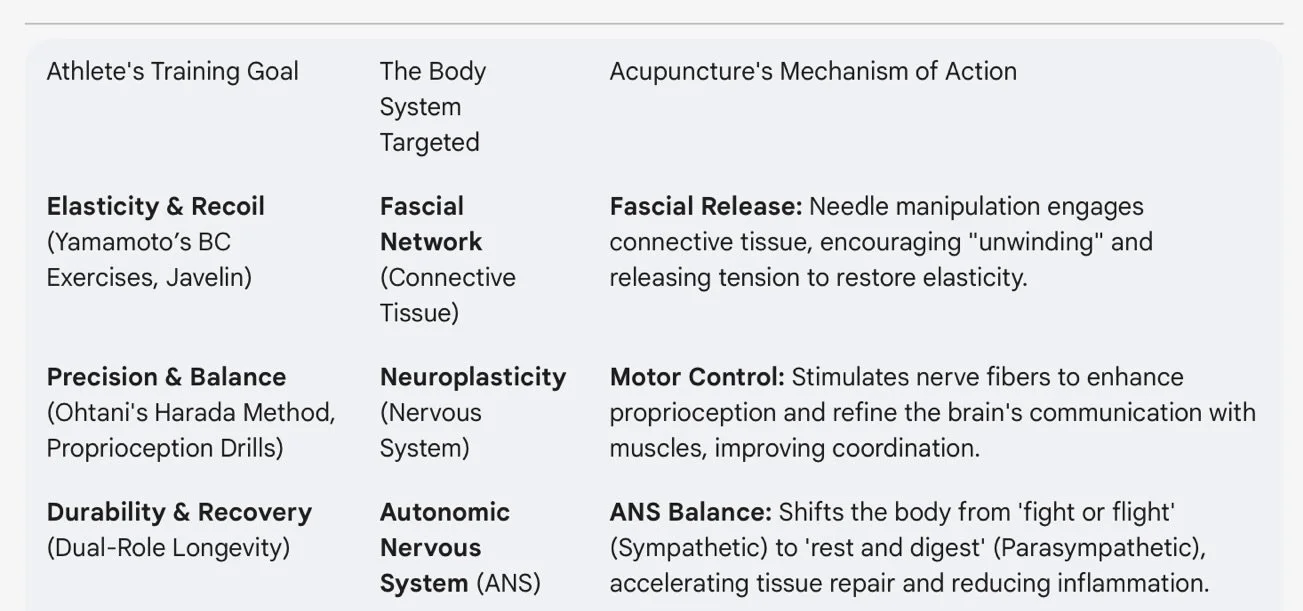From Dodger Stadium to Your Recovery: Unlocking Acupuncture and Fascial Secrets through the training of Ohtani and Yamamoto
Revolutionizing Performance: Beyond Brawn, Towards Balance
In the world of elite athletics, we often celebrate brute strength and endless hours in the weight room but what if the true secret to unlocking peak performance, preventing injury, and achieving remarkable recovery lies elsewhere? What if it's less about building massive muscles and more about cultivating a body that moves with effortless power, elastic resilience, and profound internal connection—a state of harmony that can be directly enhanced by acupuncture?
Look no further than Japanese baseball phenoms Shohei Ohtani and Yoshinobu Yamamoto. Their training regimens are a stark departure from typical Western approaches, eschewing heavy weightlifting for a meticulous focus on flexibility, elasticity, and proprioception. While you won't find "fascial training" explicitly in their daily schedules, their results—unprecedented power, durability, and a commanding presence on the field—are a living testament to the principles of optimal fascial health and neuroplasticity.
This isn't just about baseball; it's about a paradigm shift in understanding the human body's potential. Acupuncture recognizes the body as a network of connected systems, making it the perfect complementary therapy. For those seeking to enhance their athletic journey, recover faster, and move with greater freedom, acupuncture offers a powerful, evidence-based pathway to optimize these very same systems by engaging the body's connective tissue and central nervous system.
The Fascial Network: Your Body's Hidden Power Grid
Imagine your body not as a collection of individual muscles, but as a seamlessly interconnected web. This is your fascial system—a complex matrix of connective tissue that wraps around every muscle, organ, bone, and nerve. Far from being inert packing material, fascia plays a crucial role in:
Power Transmission: It stores and releases elastic energy, acting like a spring that allows for explosive movements. Think of a cheetah running or a baseball pitcher throwing 100 mph—much of that power comes from fascial recoil.
Coordination and Movement: It links different body parts, ensuring smooth, coordinated motion.
Proprioception: It's densely packed with nerve endings, constantly communicating with your brain about your body's position and movement in space.
Injury Prevention and Recovery: Healthy, hydrated fascia allows muscles to slide past each other smoothly, preventing friction, reducing stiffness, and aiding in tissue repair.
Traditional training often isolates muscles, but fascial training emphasizes whole-body integrity, encouraging interconnected movement patterns.
Yamamoto's Elasticity: A Masterclass in Fascial Fitness
Yoshinobu Yamamoto, with his "no weightlifting" philosophy, is a prime example of optimizing the fascial system. His "BC Exercises" and the "5B Method" focus on:
Mobility and Range of Motion: Contortionist yoga, back bends, and complex rolls promote extensive flexibility, directly addressing fascial restrictions.
Body Control and Proprioception: Handstands, balance drills, and the javelin throw demand acute body awareness, refining the communication between his brain and his fascia-rich tissues.
This isn't about weak muscles; it's about intelligent movement. By prioritizing elasticity and efficient force transfer, Yamamoto cultivates a body that generates immense power with minimal stress, a hallmark of a well-tuned fascial network.
Neuroplasticity: The Brain-Body Connection
Beyond the physical, the success of athletes like Ohtani and Yamamoto also highlights the profound impact of neuroplasticity—the brain's incredible ability to adapt and rewire itself.
Skill Acquisition: When you learn a new movement or refine an existing one (like Yamamoto's javelin throws or Ohtani's precise pitch mechanics), your brain creates and strengthens new neural pathways.
Enhanced Proprioception: The constant sensory feedback from complex, multi-joint movements helps the brain map the body with greater precision, leading to improved balance, coordination, and agility.
Ohtani's Harada Method, with its meticulous breakdown of goals into daily, precise actions, is a prime example of training the mind to optimize the body. It's a systematic, holistic approach to "rewiring" habits and refining motor control at the neurological level.
Acupuncture: Tapping into the Fascial and Neurological Matrix
Acupuncture is not merely a tool for pain management; it is a neurological and connective tissue treatment that directly accelerates the same physiological processes Ohtani and Yamamoto seek to optimize through training. It acts as a targeted catalyst to enhance the three pillars of high-level performance: Recovery, Mind-Body Connection, and Nervous System regulation.
1. Accelerated Recovery
Acupuncture is an ideal modality for managing the stress of intense training and speeding up the return to peak form.
Acupuncture needles, when inserted into specific points, engage the connective tissue. Studies show that needle manipulation can induce a "fascial unwinding" effect, releasing tension and improving tissue glide [1]. This isn't just a localized effect; because fascia is interconnected, releasing tension in one area can positively impact movement and reduce stiffness throughout the body.
Enhanced Elasticity: By reducing fascial restrictions, acupuncture can help restore the natural elasticity of tissues, supporting the very "spring-like" power generation seen in athletes like Yamamoto, and helping you achieve a greater range of motion without pain.
Improved Recovery: Relaxing constricted fascia can improve local blood flow and lymphatic drainage, accelerating the removal of metabolic waste and reducing inflammation after intense training. preparing it for the next training session.
2. Mind-Body Connection Acupuncture and Neuroplasticity
The therapeutic effects of acupuncture are deeply rooted in its ability to modulate the nervous system and promote neuroplastic changes.
A common phenomenon in movement science is that a muscle that feels tight or stiff is often neurologically inhibited (or weak) rather than actually short and strong. The feeling of tightness can be a protective response—the nervous system increases the tone of a muscle to create pseudo-stability because a functionally weak muscle or its antagonist is not engaging correctly.
This pattern, often stemming from pain or injury, leads to a dysfunctional signal, where the brain is essentially "dimming" the muscle's ability to contract fully.
Acupuncture, particularly techniques targeting motor points, directly addresses this issue by using a precise needle stimulus to "reset" the neuromuscular signal. This targeted stimulation bypasses the chronic inhibition, instantly restoring full communication between the nervous system and the muscle, allowing the muscle to relax and fire properly.
Pain Modulation: Acupuncture activates pathways in the brain that reduce pain perception, allowing athletes to train more effectively and recover from injuries with less discomfort [2].
Motor Control and Proprioception: By stimulating specific nerve fibers, acupuncture can enhance proprioceptive awareness and refine motor control. This can be particularly beneficial for athletes seeking to improve their balance, coordination, and the precision of their movements, much like the detailed body mapping Yamamoto undertakes [3].
3. Nervous System Regulation
Acupuncture helps regulate the autonomic nervous system, shifting the body from a "fight or flight" (sympathetic) state to a "rest and digest" (parasympathetic) state. This promotes deeper relaxation, more efficient recovery, and optimal physiological functioning crucial for peak performance.
Integrate for Peak Performance and Lasting Health
Just as Ohtani and Yamamoto are redefining baseball, you can redefine your own athletic potential by embracing a holistic, fascia- and neuroplasticity-informed approach to training and recovery. It’s time to move beyond conventional wisdom and tap into your body's extraordinary hidden power.
📍 Local Recovery for LA Athletes
For Angelenos, especially those close to Dodger Stadium, Echo Park, or Angelino Heights, Golden Mean Acupuncture is happy to support your journey.
References:
[1] Langevin, H. M., & Yandow, J. A. (2002). Relationship of acupuncture points and meridians to connective tissue planes. Anatomical Record (Hoboken, N.J.: 2007), 269(6), 257-261.
[2] Vickers, A. J., Cronin, A. M., Maschino, A. C., Lewith, L., MacPherson, H., Foster, N. E., ... & Linde, K. (2012). Acupuncture for chronic pain: individual patient data meta-analysis. Archives of internal medicine, 172(19), 1444-1453.
[3] Li, Q., Lin, C., Du, Y., Dong, Q., & Li, C. (2016). Acupuncture at acupoints of the lower limbs improves walking function in patients with chronic stroke: a randomized controlled trial. Journal of Physical Therapy Science, 28(4), 1121-1126.

